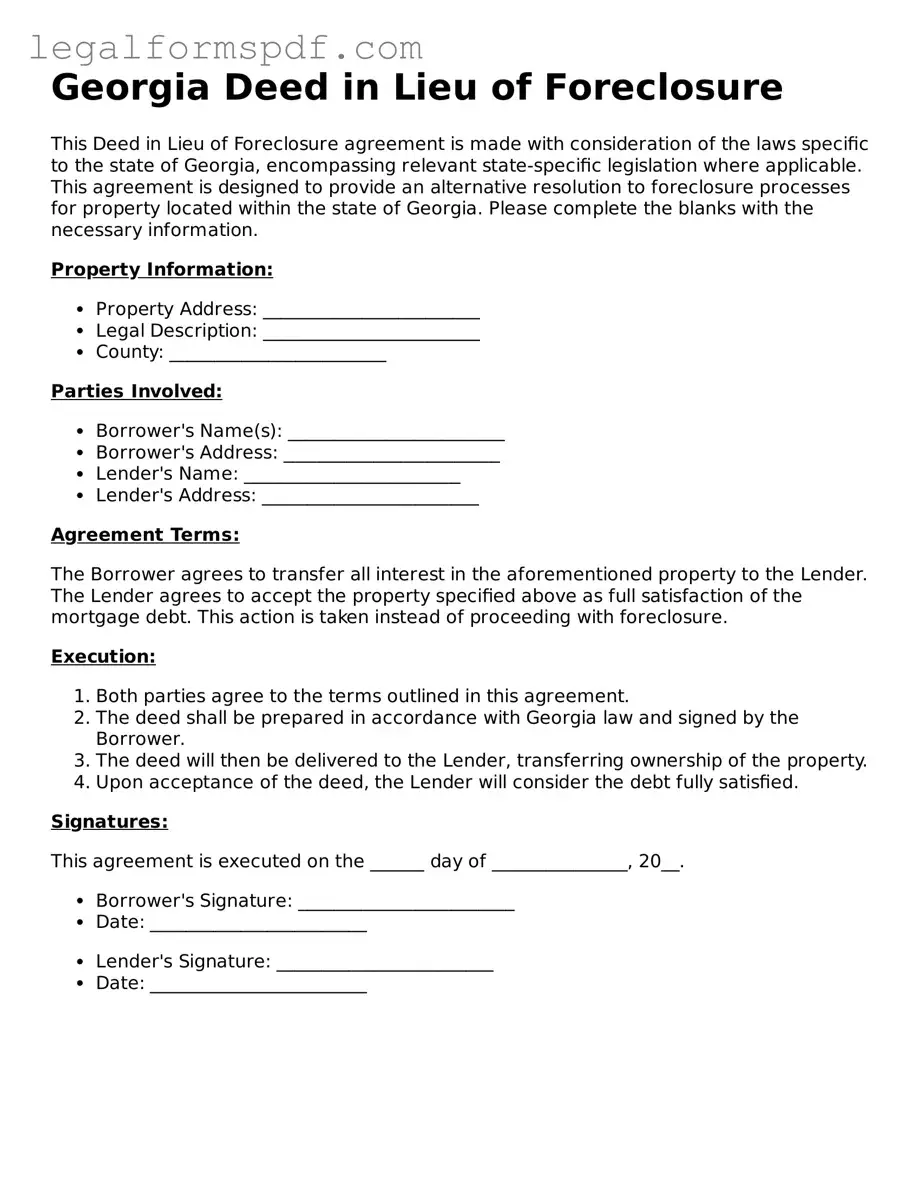A Deed in Lieu of Foreclosure form, particularly in Georgia, bears a resemblance to a Quitclaim Deed in several respects. Both documents are instrumental in transferring property rights from one party to another without the sale of the property. Unlike the typical warranty deeds, these do not guarantee the title's clearness; instead, they transfer the owner's interests as is, possibly with encumbrances. The main difference lies in their use, where a Quitclaim Deed is often used to clear up title issues or transfer property between family members, while a Deed in Lieu transfers property back to the lender to avoid foreclosure.
Similar to a Warranty Deed, the Georgia Deed in Lieu of Foreclosure facilitates the transfer of property. However, a Warranty Deed is distinguished by providing the grantee (usually the buyer) with certain guarantees about the property's title and its freedom from liens, which is not the case in a Deed in Lieu. In providing these guarantees, the Warranty Deed ensures a cleaner and more secure transfer of property compared to the as-is nature of a Deed in Lieu.
The Mortgage Agreement also shares similarities with a Deed in Lieu of Foreclosure because both involve a relationship between a borrower and a lender concerning property ownership. While a Mortgage Agreement outlines the terms under which a lender provides funds to a borrower with the property acting as collateral, a Deed in Lieu represents one outcome when the borrower cannot meet these terms, opting to transfer the property to the lender voluntarily.
Loan Modification Agreement forms and Deeds in Lieu of Foreclosure are connected through their roles in addressing financial distress related to mortgages. A Loan Modification Agreement adjusts the terms of an existing loan to prevent default, often modifying interest rates, loan terms, or principal amounts. If these adjustments fail to prevent default, a Deed in Lieu may be considered as a last resort to avoid foreclosure, allowing the borrower to relinquish the property to the lender.
The Short Sale Agreement presents another method for homeowners to avoid foreclosure, akin to the Deed in Lieu of Foreclosure. In a Short Sale, the property is sold for less than the amount owed on the mortgage with the lender's permission. This approach, like a Deed in Lieu, offers an escape from mortgage distress, although it involves finding a buyer for the property, unlike the immediate transfer involved in a Deed in Lieu.
Foreclosure Notices, while not agreements themselves, are precursors to the same financial distress situation that a Deed in Lieu of Foreclosure seeks to resolve. These notices legally inform a borrower that the foreclosure process is about to begin due to default in payment. Opting for a Deed in Lieu can be a direct response to such a notice, aiming to preclude the formal and public foreclosure process.
The Satisfaction of Mortgage document marks the end of a mortgage through the payment or fulfillment of its terms, paralleling the Deed in Lieu where the mortgage ends, not through fulfillment, but through the transfer of the property title. Both signify an end to the obligations under the original mortgage agreement, though through very different means – one through satisfaction, the other through surrender.
Assignment of Rents forms, commonly used in real estate financing, resemble the Deed in Lieu in scenarios involving rental properties. These documents allow the lender to collect rent from a property used as collateral on a loan, which becomes relevant when a borrower defaults. Similarly, a Deed in Lieu transfers ownership of the property, including any rights to collect rents, back to the lender but through a different mechanism.
Lastly, the Trust Deed is akin to the Deed in Lieu of Foreclosure as both involve three parties: the borrower (trustor), the lender (beneficiary), and a neutral third party who holds the title until the loan is repaid or, in the case of default, facilitates the transfer of property. However, a Trust Deed is employed at the inception of a loan to secure it, while a Deed in Lieu is a means to resolve the loan's default without resorting to foreclosure proceedings.
Power of Attorney documents, which authorize an individual to act on another's behalf, share an indirect similarity with a Deed in Lieu of Foreclosure. They are alike in that they both involve the transfer of rights: a Power of Attorney may include the transfer of authority to manage or dispose of the grantor's property, whereas a Deed in Lieu involves the transfer of the property itself. However, the situations in which each is used are markedly different, with one focusing on representation and the other on resolving mortgage default.
